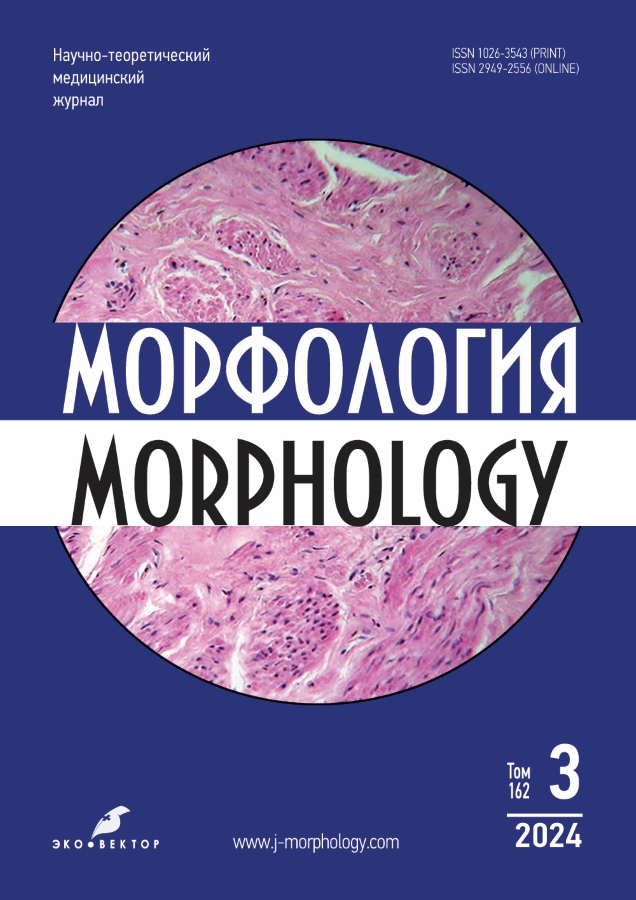胎儿和新生儿心脏下锥状间隙肌腱的解剖特征:实验性研究
- 作者: Yakimov A.A.1,2, Dmitrieva E.G.1,2, Gaponov A.A.1,2
-
隶属关系:
- Ural State Medical University
- Ural Federal University
- 期: 卷 162, 编号 3 (2024)
- 页面: 276-286
- 栏目: Original Study Articles
- ##submission.dateSubmitted##: 21.04.2024
- ##submission.dateAccepted##: 30.09.2024
- ##submission.datePublished##: 15.12.2024
- URL: https://j-morphology.com/1026-3543/article/view/630583
- DOI: https://doi.org/10.17816/morph.630583
- ID: 630583
如何引用文章
详细
论证。了解胎儿和新生儿心脏下锥状间隙肌腱(Todaro tendon,TT)的解剖学特征对围产期心外科(如左心房入路)非常重要,但实际上尚未进行研究。
目的 — 评估在宏观显微镜下解剖和研究TT的可行性,并获得有关其在胎儿和新生儿心脏中的存在、形状、大小、分支和局部地形的初步数据。
材料和方法。对15个宫内发育16~40周的正常人心脏样本进行了研究。使用Olympus SZX2-ZB10显微镜(Olympus,日本)以6.3至30的放大倍数解剖10个心脏。使用分辨率为10 MP的Levenhuk M1000 PLUS相机(Levenhuk,俄罗斯)和Levenhuk lite软件,测量了TT的长度和宽度。求出算术平均值、标准差、中位数、极值、变异系数和Spearman相关系数。制备五颗心脏的组织切片,并按照Masson染色法进行染色。
结果。在所有制备样本中均检测到TT,TT总是位于心内和/或下锥状间隙的疏松结缔组织中。在所有病例中,TT都从右纤维三角开始,心房心室束和结节的前方和上方的TT最为单一。TT沿着卵圆孔下缘和冠状窦开口之间延伸,最后到达下腔静脉瓣。10例中有6例TT无分支,10例中有4例分为两个分支,覆盖冠状窦口。在一份样本中,制备了到达右冠状动脉的TT纤维。下腔静脉瓣部TT的宽度中位数 (0.35mm) 与其长度 (4.63mm; Rs=0.821; p=0.023) 和原点处的宽度 (0.24mm; Rs=0.929; p=0.0003)相关。
结论。在人发育的产前后期和围产期,心脏下锥状间隙的肌腱具有解剖结构的可变性和地形恒定的特点。结构的可变性表现为肌腱分支和宽度值变异,尤其是宽度。地形的恒定性在于肌腱的起点、连续和终点的不变性。胎儿和新生儿心脏中的这种肌腱可以通过宏观显微镜解剖来找出。
全文:
作者简介
Andrey A. Yakimov
Ural State Medical University; Ural Federal University
编辑信件的主要联系方式.
Email: ayakimov07@mail.ru
ORCID iD: 0000-0001-8267-2895
SPIN 代码: 8618-2991
MD, Cand. Sci. (Medicine), Associate Professor
俄罗斯联邦, Ekaterinburg; EkaterinburgEugenia G. Dmitrieva
Ural State Medical University; Ural Federal University
Email: anmayak@mail.ru
ORCID iD: 0000-0002-2973-3481
SPIN 代码: 7966-8133
俄罗斯联邦, Ekaterinburg; Ekaterinburg
Anton A. Gaponov
Ural State Medical University; Ural Federal University
Email: gagaponov@gmail.com
ORCID iD: 0000-0002-6681-7537
SPIN 代码: 2841-6740
俄罗斯联邦, Ekaterinburg; Ekaterinburg
参考
- Saremi F, Sánchez-Quintana D, Mori S, et al. Fibrous skeleton of the heart: anatomic overview and evaluation of pathologic conditions with CT and MR imaging. Radiographics. 2017;37(5):1330–1351. doi: 10.1148/rg.2017170004
- Glyantsev SP, Gordeeva MV. Eponymous names of topographic landmarks and anatomical structures of a normally formed heart. Pt 1. Eponyms of the pericardium, atria and ventricles of the heart. Minimally Invasive Cardiovascular Surgery. 2023;2(2):5–17.
- Tandler J. Anatomie des Herzens. Jena: Verlag von G. Fischer; 1913. (In Deutch).
- Ho SY, Anderson RH. How constant anatomically is the tendon of Todaro as a marker for the triangle of Koch? J Cardiovasc Electrophysiol. 2000;11(1):83–89. doi: 10.1111/j.1540-8167.2000.tb00741.x
- Voboril Z. Todaro’s tendon in the heart. I. Todaro’s tendon in the normal human heart. Folia Morphol (Praha). 1967;15(2):187–196.
- Kozłowski D, Grzybiak M, Koźluk E, Owerczuk A. Morphology of the tendon of Todaro within the human heart in ontogenesis. Folia Morphol (Warsz). 2000;59(3):201–206.
- James TN. The tendons of Todaro and the “triangle of Koch”: lessons from eponymous hagiolatry. J Cardiovasc Electrophysiol. 1999;10(11):1478–1496. doi: 10.1111/j.1540-8167.1999.tb00207.x
- Shanubhogue S, Mohamed T, Shankar N. Morphometry of the triangle of Koch and position of the coronary sinus opening in cadaveric fetal hearts. Indian Heart J. 2017;69(1):125–128. doi: 10.1016/j.ihj.2016.07.004
- Domènech-Mateu JM, Martínez-Pozo A, Arnó-Palau A. Development of the tendon of Todaro during the human embryonic and fetal periods. Anat Rec. 1994;238(3):374–382. doi: 10.1002/ar.1092380312
- Bashmakova NV, Kosovtsova NV. Fetal surgery: achievements and challenges. Doctor Ru. 2017;(13-14):31–36. EDN: TAUUWD
- Spicer DE, Anderson RH. Normal Cardiac Anatomy. In: Abdulla R., editor. Pediatric Cardiology. Springer, Cham. 2023. doi: 10.1007/978-3-030-42937-9_103-1
- Ferraz-de-Carvalho CA, Liberti EA. The membranous part of the human interventricular cardiac septum. Surg Radiol Anat. 1998;20(1):13–21. doi: 10.1007/s00276-998-0013-6
- https://fipat.library.dal.ca/ [Internet]. FIPAT. Terminologia Anatomica. 2nd ed. 2019. Available from: https://fipat.library.dal.ca/ta2/
- Mori S, Nishii T, Takaya T, et al. Clinical structural anatomy of the inferior pyramidal space reconstructed from the living heart: Three-dimensional visualization using multidetector-row computed tomography. Clin Anat. 2015;28(7):878–887. doi: 10.1002/ca.22483
补充文件










